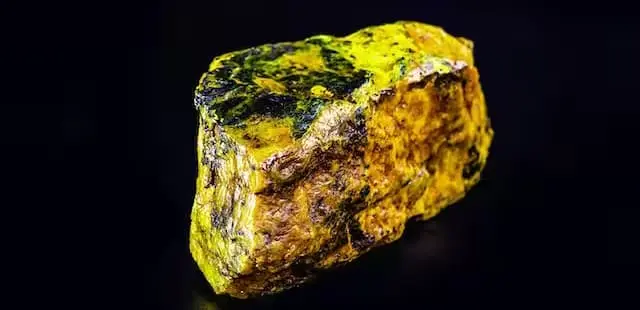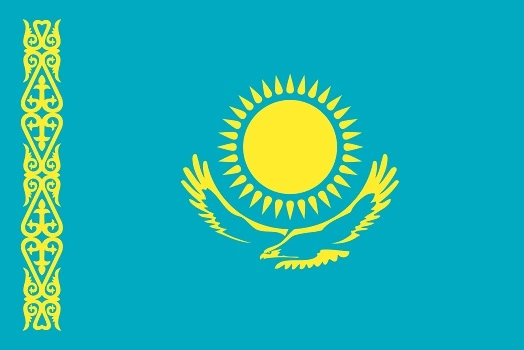The German chemist Martin Klaproth first discovered Uranium in 1789. Earth’s soil, water, and rocks all contain uranium in their natural forms. One of the heaviest naturally occurring elements, it is mined commercially from various uranium-producing minerals including uraninite. Uranium is about 18.7 times denser than water. For more than 60 years, uranium has been employed as a plentiful resource of concentrated energy because of its density.
The most often utilized fuel for industrial reactors is low-enriched uranium. The 235U content in this sort of uranium ranges from 0.711% to 20%, but when it is around 3% and 5%, it is referred to as “reactor-grade.” Nuclear weapons, marine propulsion reactors, and some research reactors all employ highly enriched uranium. The amount of 235U in high-enriched uranium is 20%. This kind of uranium was utilized in the construction of the first atomic weapon, which was detonated in Hiroshima, Japan, on August 6, 1945.
Largest Producers of Uranium in the World
With that, let’s look at the top 10 Uranium Producers in the World below –
1. Kazakhstan
Kazakhstan produced the most uranium worldwide in 2021 holding the 1st spot in this list. In actuality, the nation’s entire output of 21,810 tonnes represented 45% of the world’s uranium supply. In terms of known accessible uranium resources as of the most recent data point in 2019, Kazakhstan ranked second just to Australia with 906,800 tonnes. The majority of the nation’s uranium is mined using an in-situ leaching technique. The nation’s national uranium mining business, Kazataprom, is the largest uranium producer in the world, with a wide range of partnerships and projects in other countries.
2. Namibia
Namibia’s uranium output has been rising steadily since 2015 when it reached a record low of 2,993 tonnes. In fact, in 2020 the African country passed long-time leader Canada to take over third place in terms of uranium production, and in 2021 it overtook Australia to take over second place. The nation is home to two uranium mines with a combined capacity of 12% of global production. The Rössing mine is mostly under the hands of mining giant Rio Tinto, while uranium company Paladin Energy owns the Langer Heinrich mine. Paladin shut down Langer Heinrich in 2017 as a result of low uranium prices. The uranium miner increased restart efforts as a result of the rising spot price of uranium in 2021 and 2022. The mine will resume operations in the initial quarter of 2024, according to the business.
3. Canada
Canada acquired the third position on this list. Since reaching a record high of 14,040 tonnes in 2016, Canada’s uranium production has decreased sharply. The COVID-19 epidemic caused operational shutdowns, which resulted in a drop in Canadian uranium output from 6,938 tonnes of yellowcake uranium in 2019 to 3,880 tonnes in 2020. However, uranium production increased to 4,693 tonnes in 2021. The two best uranium mines in the world are located in Saskatchewan at McArthur River and Cigar Lake. Operating both projects is industry leader Cameco. In Canada, uranium prospecting is also fairly common, with the majority of it taking place in the Athabasca Basin, which has a lot of uranium. The high-quality uranium reserves and welcoming attitude toward miners in that particular region of Saskatchewan are well known across the world. The lengthy history of uranium mining in the province has aided Saskatchewan’s claim to be a global leader in uranium production.
4. Australia
Australia’s uranium production fell sharply in 2021 from 6,203 tonnes in 2020 to 4,192 tonnes. The island nation is home to 28% of the world’s uranium deposits that are known to be recoverable. In Australia, uranium mining activity has been a divisive and frequently politicized topic. Although the industry is closely regulated, its future is frequently questioned. The government of Western Australia has made the decision to proceed with ongoing projects, but it was clear that no new permissions will be given to domestic uranium mining projects. Many businesses are now in limbo as a result of this judgment. Olympic Dam, the world’s largest uranium deposit in the world, is located in Australia. Despite allowing some uranium mining, the nation is against the use of nuclear power.
5. Uzbekistan
With a projected 3,500 tonnes of production in 2020, Uzbekistan rose to the fifth position amongst uranium-producing nations. Since 2016, the nation of Central Asia has gradually increased its domestic uranium production. It was formerly sixth in the world for uranium production, but collaborative partnerships with Japan and China are increasing production. The nation’s uranium production for 2021 was constant at 3,500 tonnes. The whole mining and refining of the nation’s supply of uranium are done by Navoi Miner & Metallurgy Combinat, which is a subsidiary of the state-holding firm Kyzylkumredmetzoloto.
6. Russia
In terms of the output of uranium in 2021, Russia came in the sixth position. Since 2011, the nation’s output has remained consistent, typically falling in the 2,800–3,000 tonne range. Experts had predicted that the nation that produces uranium will raise its output in the upcoming years to meet both its own energy needs and the rising global demand for uranium. However, that view might be affected by Russia’s ongoing conflict in Ukraine as well as the economic sanctions that have been imposed as a response. In addition, the safety of uranium shipments from such a region has been the subject of a Section 232 inquiry by the US in recent years, raising questions about Russian uranium. In terms of national production, the Priargunsky mine and other facilities are owned by Rosatom, a division of ARMZ Uranium Holding.
7. Niger
Over the previous ten years, Niger’s uranium production has decreased year over year, reaching 2,248 tonnes in 2021. SOMAIR and COMINAK, two operating uranium mines in the African country, supply 5% of global uranium production. Both projects are run by divisions of Orano, a commercial uranium miner with operations in Canada and Kazakhstan, two of the world’s top producers of the metal. The cornerstone project of the exploration GoviEx Uranium is likewise located in Niger. The uranium firm is currently working on projects in Mali, Zambia, and its Madaeouela asset.
8. China
China comes eighth on this list. From 885 tonnes in the year 2011 to 1,885 tonnes in the year 2018, China’s uranium production increased and has been stable ever since. The only domestic uranium supplier in the nation, China General Nuclear Power (CGNP), is trying to increase its nuclear fuel supply agreements with Kazakhstan and other overseas uranium firms. China wants to source one-third of the uranium for its nuclear fuel cycle from local producers, acquire one-third through foreign ownership of mines and joint ventures abroad, and buy one-third on the open market for uranium. China is a world leader in nuclear energy, with 54 reactors already operational and another 21 under development.
9. India
In 2021, India produced 610 tonnes of fuel, up from over 400 tonnes the previous year. Over the previous ten years, the nation’s uranium production has remained constant at between 300 and 400 tonnes. The nation had 71,000 tonnes of uranium stockpiled as of 2018 for use in its national nuclear energy industry. India presently has 22 nuclear reactors in operation, and eight more are being built. As stated by the World Nuclear Association, “the Indian government is determined to increase its nuclear power output as part of its huge infrastructure building agenda.” “The administration has established challenging goals to increase nuclear capacity.”
10. Ukraine
Uranium output in Ukraine decreased to 800 tonnes in the year 2016 from a peak of 1,210 tonnes in the year 2015. Production fell to 455 tonnes in the year 2021 after remaining at approximately 800 tonnes for a few more years. 15 nuclear reactors in Ukraine, which rely significantly on this source of energy, provide nearly half of the nation’s electricity needs. The majority of Ukraine’s uranium needs were previously satisfied by Russian uranium before Russia invaded. Westinghouse did, however, pledge to supply the Ukrainian fleet with all of its fuel starting in June 2022. Only 2% of the world’s known uranium reserves are held by Ukraine; by contrast, 8% of the world’s uranium reserves are held by Russia, Ukraine’s neighbor.
Conclusion
The COVID-19 mine shutdown caused uranium production worldwide to reach its lowest point in 2020. The need for uranium has grown out of proportion to the present availability despite increased production due to sustainable energy sources. The output has been further hampered by the depletion of uranium stocks from the Cold War. It is anticipated that it will take a minimum of 15 years for uranium mining to satisfy reactor demand.
Uranium Production FAQs
Q1. How Is Uranium Mined And Extracted?
Ans: Once the precious uranium ore is accessed through open-pit or underground mining, it’s crushed and finely ground into powder form. This powder is then treated with chemicals such as sulfuric acid or alkali solutions, dissolving the uranium in the process. The liquid concoction undergoes a series of chemical procedures to isolate and concentrate the uranium. This concentrated uranium, referred to as yellowcake, is then dried and packaged for further processing.
Q2. What Is The Difference Between Natural Uranium And Enriched Uranium?
Ans: Natural uranium is the raw form of uranium extracted from the earth without undergoing any additional processing. It is a blend of uranium isotopes, mainly uranium-238 (U-238), and a smaller amount of uranium-235 (U-235). Conversely, enriched uranium is uranium that has gone through a process called enrichment, which increases the concentration of the U-235 isotope.
Q3. How Is Uranium Priced In The Global Market And What Factors Affect Its Price?
Ans: In the international market, uranium’s value is determined by its weight and enrichment level, measured in pounds of U3O8 (triuranium octoxide). The price of uranium is subject to various factors, including supply and demand dynamics, production costs, geopolitical tensions, and the overall state of the global economy.
Q4. Can Uranium Be Used For Purposes Other Than Energy Production?
Ans: Depleted uranium, a byproduct of the enrichment process, boasts high density, making it suitable for creating armor-piercing ammunition and protective shielding for military vehicles. Furthermore, uranium isotopes find utility in diverse medical and industrial applications, such as producing radioisotopes for cancer treatment and radiography.
Q5. How Do Countries With Abundant Natural Uranium Reserves Use Them For Economic And Strategic Purposes?
Ans: Countries with abundant natural uranium reserves can reap economic benefits by exporting uranium to other nations, thereby generating revenue and contributing to their GDP. Strategically, these reserves offer energy security, diminishing reliance on imported fossil fuels for electricity generation. Moreover, countries with domestic uranium production capabilities can leverage their resources to develop and maintain nuclear technology for both peaceful and military objectives.
























